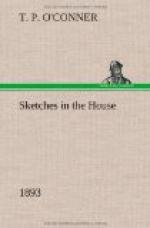[Sidenote: A muttered soliloquy.]
Finally, the speech also had the narrowness, shallowness, and unreality of the hermit’s soliloquy. In the main, there was no insight. A logic-chopper, a dialectician—even in some respects a musing philosopher—such Lord Salisbury is; but breadth, depth, clear vision—of that there was not a trace in the whole speech. And then you went back in memory to the other speech—so clear, so broad-directed, yet uttered by a man who looked straight before him and all around him—who felt the presence in his every nerve of that assembly there which he was addressing; who lived and saw instead of dreaming—and you could come to no other conclusion than that of the two leaders of the House of Lords, the young man was the statesman and the man of action as well as the orator, and that it was worth the spending even all the weary hours of this past week in the House of Lords to learn so much of these great protagonists in our Parliamentary struggles.
[Sidenote: Anti-climax.]
Of other speakers I say but little. I came in during the dinner hour to see a very little man with what we call in Ireland a “cocked” nose, a conceited mouth, and a curious mixture of the unctuousness and benedictory manner of the pulpit and the limp twitterings of the curate at a ladies’ tea-fight. This was the head of the Bishop of Ripon. I cannot stare for even a second at this tiny tomtit and artificial figure, with all those lawn sleeves and black gowns, and all the other fripperies and draperies of the parson-peer, who is to every rational man so grotesque and contemptible an intruder in a legislative chamber. In the grim and crowded gallery of the personages of an Irish Epic, such an intruder is like the thin piping note of a tiny bird mid the carnage and shouts and roars of a battle-field.
Everybody knows the result of the division: for the Bill, 41; against, 419; majority, 378. It was a conclusion that was foregone, but the Lords themselves recognized the comic futility of it. The attempted cheers ended in one loud, mocking, universal laugh. And thus the curtain fell on the historic drama of the great Home Rule Session.
T.P.
THE END.




